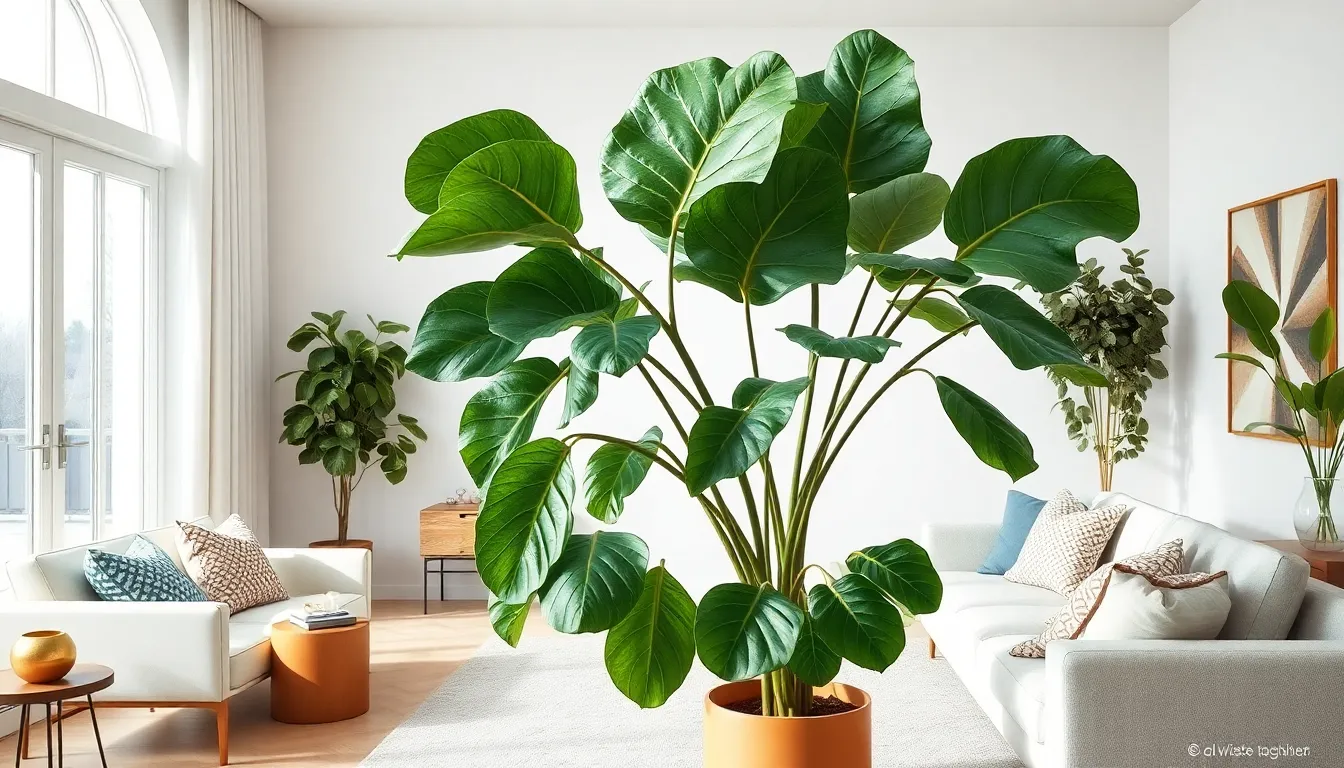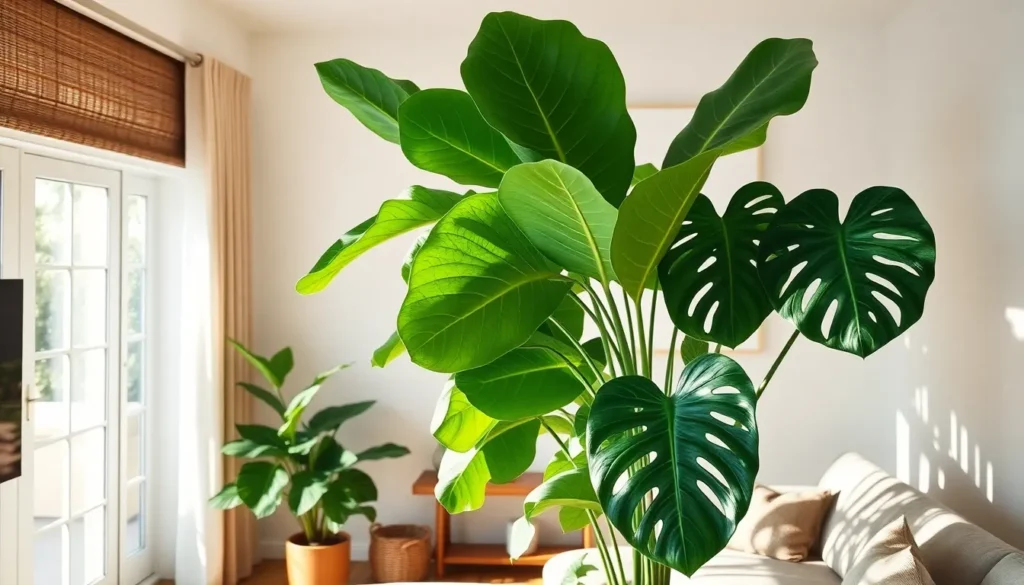Table of Contents
ToggleIf you think size doesn’t matter, you’ve never met a big house plant. These leafy giants not only elevate your home decor but also transform your living space into a lush oasis. Imagine walking into a room and being greeted by a towering fiddle leaf fig or a majestic monstera. It’s like having a personal rainforest right in your living room—minus the humidity and the risk of encountering a snake!
Overview of Big House Plants
Big house plants significantly enhance indoor environments. They provide visual interest and contribute to healthier air quality. Varieties like fiddle leaf figs and monsteras showcase striking foliage, making them popular choices for diverse spaces.
Plants such as rubber trees and snake plants also stand out. A rubber tree can grow up to 10 feet tall indoors, while snake plants can thrive in low light, adding versatility. These plants not only decorate but also purify the air by removing toxins.
Consider maintenance requirements when selecting large plants. Some, like the ZZ plant, tolerate neglect and low light, while others, such as hibiscus, require more attention, including regular watering and sunlight.
Placement matters significantly. Large plants work well in corners, near windows, or as statement pieces in the center of a room. Those with broad leaves, such as the palm, create a tropical feel, while tall, narrow plants like the dracaena complement modern aesthetics.
Purchasing from reputable sources ensures healthy specimens. Local nurseries often provide expert guidance, helping identify species best suited for specific environments and lighting conditions. Diverse options available in stores include palm varieties, rubber trees, and peace lilies, each with unique characteristics.
Big house plants transform spaces, fostering tranquility and enhancing decor. By considering size, placement, and maintenance, individuals can enjoy the benefits of these vibrant additions to their homes.
Benefits of Big House Plants

Big house plants offer numerous advantages for indoor spaces. These benefits range from air purification to enhanced aesthetics.
Improved Air Quality
Large plants significantly boost indoor air quality. They absorb toxins like formaldehyde and benzene, which often linger in home interiors. Snake plants and rubber trees excel in removing harmful elements from the air. According to a study by NASA, indoor plants can reduce airborne pollutants by up to 87% within 24 hours. In addition, big house plants release oxygen, contributing to fresher air circulation. Healthier environments promote overall well-being, making them a smart choice for homes.
Aesthetic Appeal
Massive house plants enhance decor by adding vibrant greens to living areas. They serve as striking focal points, creating inviting atmospheres. Large specimens like fiddle leaf figs and monsteras complement minimalist and eclectic designs alike. Placing these plants in corners or as statement pieces creates a sense of depth and dimension. Furthermore, their presence can soften hard surfaces, leading to a more welcoming environment. Integrating big plants into design schemes enriches visual interest, elevating the ambiance of any room.
Popular Varieties of Big House Plants
Many big house plants stand out for their beauty and impact in interior spaces. A few top choices include the fiddle leaf fig and monstera deliciosa.
Fiddle Leaf Fig
Fiddle leaf figs are known for their large, glossy leaves that make a bold statement. These plants can reach heights of up to 10 feet, making them ideal for filling empty corners or drawing attention to a room. Preferring bright, indirect light, they thrive near windows while adding elegance. Visible support is needed for stability as they grow, especially in windier areas. Regular watering ensures a healthy plant, but overwatering should be avoided to prevent root rot. This tropical plant elevates any indoor environment, transforming the atmosphere significantly.
Monstera Deliciosa
Monstera deliciosa, often called the Swiss cheese plant, features unique leaf holes that create visual interest. It can grow up to 8 feet tall, making it a striking centerpiece for any room. Thriving in medium to bright indirect light, it adapts well to various light conditions. Regular watering keeps the soil slightly moist; however, it’s essential to allow it to dry out between watering sessions. Pruning ensures a bushy appearance while limiting excessive growth. With its eye-catching foliage, monstera deliciosa adds a touch of the tropics, creating a vibrant living space.
Care Tips for Big House Plants
Caring for large house plants involves understanding their specific needs to ensure healthy growth. Attention to light and watering plays a significant role in maintaining vibrant greenery.
Light Requirements
Bright, indirect light suits many big house plants best. Fiddle leaf figs thrive under these conditions, making them ideal for well-lit rooms. Monstera deliciosa can adapt to lower light levels but prefers medium to bright light for optimal growth. Positioning plants near windows helps them absorb necessary sunlight. Avoid direct sunlight, as it can scorch leaves and hinder growth. Supplementing with artificial light can support plants that need additional exposure during darker months.
Watering Needs
Proper watering techniques foster healthy big house plants. Many species, including rubber trees, prefer to dry out slightly between waterings. Checking the top inch of soil can indicate when it’s time to water again. Overwatering leads to root rot, especially in plants like ZZ plants that thrive on minimal moisture. Conversely, snake plants tolerate drought thanks to their thick leaves but benefit from regular watering during the growing season. Always ensure pots have drainage holes to facilitate excess water release.
Common Pests and Diseases
Common pests and diseases can pose threats to large house plants. Spider mites, for instance, often attack plants like rubber trees and fiddle leaf figs. Symptoms include webbing and yellowed leaves, which indicate damage. Aphids also create issues, showing up on new growth and causing distortion. Treating infestations with insecticidal soap or neem oil helps manage these pests effectively.
Fungus gnats frequently affect plants with moist soil, such as snake plants and peace lilies. Their larvae feed on plant roots, leading to stunted growth. Allowing the top inch of soil to dry before watering can reduce these pests. Root rot emerges in overwatered conditions, primarily affecting plants like monsteras. Signs of root rot include wilting leaves and a foul odor from the soil. Ensuring proper drainage and letting the soil dry out between waterings prevents such issues.
Powdery mildew appears on leaves under high humidity conditions and poor air circulation. This white fungal growth can damage foliage, requiring a mixture of water and baking soda for treatment. Brown spots often indicate sunburn, particularly in direct sunlight situations. Gentle repositioning to a shadier spot alleviates sunburnt leaves.
Regular checks for these common pests and diseases aid in maintaining healthy large house plants. By identifying issues early, she can implement necessary treatments promptly. Additionally, ensuring optimal care and monitoring environmental conditions promotes plant well-being, contributing to an inviting atmosphere in the home.
Big house plants are more than just decorative elements; they breathe life into living spaces. Their ability to purify air while providing a lush aesthetic makes them invaluable in modern homes. With the right selection and care, these plants can thrive and enhance any room.
Choosing the right spot for these green giants can create stunning focal points that draw the eye and elevate the overall ambiance. Whether opting for a striking fiddle leaf fig or a unique monstera, the benefits of incorporating large plants into home decor are undeniable.
With thoughtful consideration of their needs and potential challenges, anyone can enjoy the tranquility and beauty that big house plants bring to their environment.







